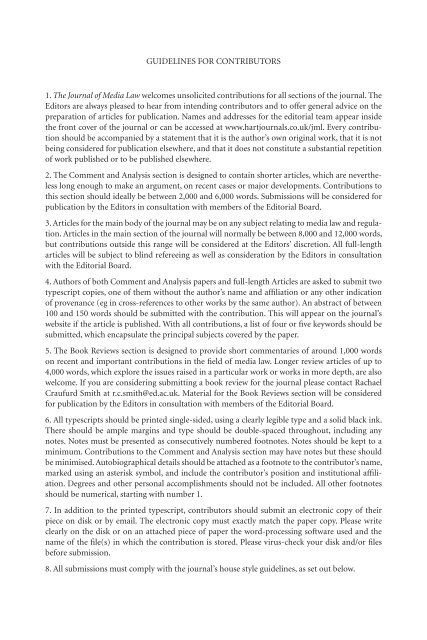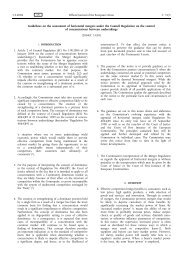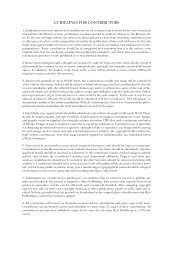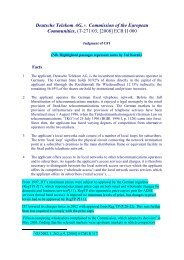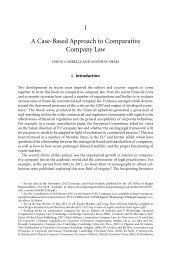GUIDELINES FOR CONTRIBUTORS 1. The ... - Hart Publishing
GUIDELINES FOR CONTRIBUTORS 1. The ... - Hart Publishing
GUIDELINES FOR CONTRIBUTORS 1. The ... - Hart Publishing
Create successful ePaper yourself
Turn your PDF publications into a flip-book with our unique Google optimized e-Paper software.
<strong>GUIDELINES</strong> <strong>FOR</strong> <strong>CONTRIBUTORS</strong><br />
<strong>1.</strong> <strong>The</strong> Journal of Media Law welcomes unsolicited contributions for all sections of the journal. <strong>The</strong><br />
Editors are always pleased to hear from intending contributors and to offer general advice on the<br />
preparation of articles for publication. Names and addresses for the editorial team appear inside<br />
the front cover of the journal or can be accessed at www.hartjournals.co.uk/jml. Every contribution<br />
should be accompanied by a statement that it is the author’s own original work, that it is not<br />
being considered for publication elsewhere, and that it does not constitute a substantial repetition<br />
of work published or to be published elsewhere.<br />
2. <strong>The</strong> Comment and Analysis section is designed to contain shorter articles, which are nevertheless<br />
long enough to make an argument, on recent cases or major developments. Contributions to<br />
this section should ideally be between 2,000 and 6,000 words. Submissions will be considered for<br />
publication by the Editors in consultation with members of the Editorial Board.<br />
3. Articles for the main body of the journal may be on any subject relating to media law and regulation.<br />
Articles in the main section of the journal will normally be between 8,000 and 12,000 words,<br />
but contributions outside this range will be considered at the Editors’ discretion. All full-length<br />
articles will be subject to blind refereeing as well as consideration by the Editors in consultation<br />
with the Editorial Board.<br />
4. Authors of both Comment and Analysis papers and full-length Articles are asked to submit two<br />
typescript copies, one of them without the author’s name and affiliation or any other indication<br />
of provenance (eg in cross-references to other works by the same author). An abstract of between<br />
100 and 150 words should be submitted with the contribution. This will appear on the journal’s<br />
website if the article is published. With all contributions, a list of four or five keywords should be<br />
submitted, which encapsulate the principal subjects covered by the paper.<br />
5. <strong>The</strong> Book Reviews section is designed to provide short commentaries of around 1,000 words<br />
on recent and important contributions in the field of media law. Longer review articles of up to<br />
4,000 words, which explore the issues raised in a particular work or works in more depth, are also<br />
welcome. If you are considering submitting a book review for the journal please contact Rachael<br />
Craufurd Smith at r.c.smith@ed.ac.uk. Material for the Book Reviews section will be considered<br />
for publication by the Editors in consultation with members of the Editorial Board.<br />
6. All typescripts should be printed single-sided, using a clearly legible type and a solid black ink.<br />
<strong>The</strong>re should be ample margins and type should be double-spaced throughout, including any<br />
notes. Notes must be presented as consecutively numbered footnotes. Notes should be kept to a<br />
minimum. Contributions to the Comment and Analysis section may have notes but these should<br />
be minimised. Autobiographical details should be attached as a footnote to the contributor’s name,<br />
marked using an asterisk symbol, and include the contributor’s position and institutional affiliation.<br />
Degrees and other personal accomplishments should not be included. All other footnotes<br />
should be numerical, starting with number <strong>1.</strong><br />
7. In addition to the printed typescript, contributors should submit an electronic copy of their<br />
piece on disk or by email. <strong>The</strong> electronic copy must exactly match the paper copy. Please write<br />
clearly on the disk or on an attached piece of paper the word-processing software used and the<br />
name of the file(s) in which the contribution is stored. Please virus-check your disk and/or files<br />
before submission.<br />
8. All submissions must comply with the journal’s house style guidelines, as set out below.
Journal of Media Law<br />
House style<br />
Except where specifically noted below, the house style follows the Oxford Standard Citation for<br />
Legal Authorities (OSCOLA). OSCOLA can be downloaded at www.law.ox.ac.uk/publications/<br />
oscola.php. While OSCOLA is not a style guide, the introduction to it includes a few recommended<br />
texts that will prove useful to contributors.<br />
Spelling<br />
• Standard UK spelling: ‘-ise’ / ‘-isation’ / ‘-ising’. ‘z’ should remain when quoting sources.<br />
• Use UK English spellings in your text: ‘colour’, ‘favour’, etc.<br />
Punctuation<br />
• Use single quotation marks, reserving double ones for quoted matter within a quotation.<br />
• Ellipsis: use three full points spaced from the words on either side to indicate matter omitted<br />
from a quotation … like this. Do not use an extra full point to indicate the end of a sentence<br />
before or after the ellipsis.<br />
• Do not use the serial comma – ie, the comma before ‘and’ or ‘or’ in lists of three or more items,<br />
unless it is necessary for the sake of sense: ‘red, white and blue’.<br />
• Abbreviations and initials should not be given full points, and no extra spaces should be added.<br />
Thus ‘eg’ is correct rather than ‘e.g.’, HLA <strong>Hart</strong> not H.L.A. <strong>Hart</strong> or H L A <strong>Hart</strong>.<br />
Italics<br />
• Use italics for emphasis, not bold.<br />
• Italicise foreign words and terms including ibid, sic and passim. Do not italicise ‘cf’ or ‘see also’,<br />
etc. Generally, where a foreign word is in common usage, do not italicise.<br />
• Use italics for the titles of books, journals, works of art, films, and the names of ships.<br />
Abbreviations<br />
• Spell out all but the commonest abbreviations at the first mention in your paper; thereafter, an<br />
abbreviation may be used without explanation. Exception: all journal titles must be given in<br />
full.<br />
• Use ‘per cent’ in the text unless it appears many times, in which case use %. <strong>The</strong> latter may be<br />
used in footnotes.<br />
Quotations<br />
Quotations of more than 40 words in length, or particularly significant quotations, should be broken<br />
off from the main text and ‘displayed’. Leave an extra line space above and below the displayed<br />
quotation, and indent it by adjusting the left margin. Do not key it in italic type.<br />
Numbers<br />
• Omit as many digits as possible in number ranges, except between 11 and 99 and between 10<br />
and 19 in any hundred: 25–26, 120–2, 318–19. Do not elide figures when a range of years is<br />
referred to crossing between centuries: 1820–1910.
Journal of Media Law<br />
3<br />
• Dates are formulated in the order day, month, year, without commas: 11 November 1918.<br />
• Spell out numbers up to nine and use figures from 10. However, use figures for: units of measure:<br />
‘30 kilometres’; dates: ‘9 September 2001’; people’s ages: ‘she was 58 years old’. Use words<br />
at the beginning of a sentence: ‘Two hundred and fifty gold bars were stolen’, and for approximate<br />
numbers: ‘At least a thousand people were present.’<br />
Websites<br />
• Omit ‘http://’ where the web address begins ‘www’; otherwise leave it in.<br />
• Please double-check that web addresses are accurate before submitting your paper.<br />
• Where several web addresses appear in your footnotes, indicate in the first (asterisked) footnote<br />
the date on which you double-checked the addresses. Otherwise indicate the date in<br />
brackets after the website.<br />
Examples<br />
* Lecturer, University of Cambridge, UK. All websites accessed 6 February 2013.<br />
or<br />
25 www.law.ox.ac.uk/publications/oscola.php (accessed 6 February 2013).<br />
Cases, legislation etc<br />
• Case references should be given in full the first time they are mentioned.<br />
• Do not include a full stop after the ‘v’ in case names: Roe v Wade.<br />
• Do not italicise the titles of legislation and other primary sources: UN Convention, Working<br />
Time Directive, Accident Compensation Act 1972 (NZ).<br />
• Please refer to OSCOLA for other aspects of house style regarding cases etc.<br />
Books, journals etc<br />
• Authors’ first names should appear in full unless the common convention is to use initials<br />
only: HLA <strong>Hart</strong>, FW Maitland, but Hans Kelsen, John Finnis.<br />
• Books should be cited in the following form: author, | Title | (publisher, edition year) | page<br />
number if necessary.<br />
• Article citations should be set out as follows: author, | ‘Title’ | (year) | volume(issue) | Journal<br />
Name | start page (not the complete page range).<br />
• Please note that, in contrast to the OSCOLA requirements, all journal titles should be given in<br />
full and italicised.<br />
• Chapters in books should be set out as follows: author, | ‘Chapter Title’ in | Editor Name (ed),<br />
| Title | (publisher, edition year) | chapter/page number(s).<br />
• Refer to works already cited as follows: ‘See Maitland (n 3) 435’.<br />
• ‘Ibid’ should be used where a reference is to the immediately preceding note, while ‘ante’, ‘post’,<br />
‘op cit’, ‘loc cit’, ‘supra’ and ‘infra’ should all be avoided. Do not include a full stop after ‘n’ or<br />
after ‘ibid’.
Journal of Media Law<br />
Examples<br />
1 Mary Bickel, <strong>The</strong> Least Dangerous Tree (Yale University Press, 2nd edn 2013) 34.<br />
2 A King, ‘Institutional Approaches to Judicial Restraint’ (2008) 28 Oxford Journal of Legal Studies<br />
409.<br />
3 Ibid, 412.<br />
4 Evan Keating, ‘<strong>The</strong> Liability of the World’ in Stephen Williams and Xander Mulhall (eds), This<br />
is the Book (Yale University Press, 2013) 245–312.<br />
5 See Bickel (n 1) 37.<br />
Book reviews<br />
To refer to page numbers within the work under review, insert the page number in parentheses<br />
within the text. Do not precede this with ‘p’ or ‘pp’. For example: ‘<strong>The</strong> content of a human right is<br />
also the content of the corresponding duty (97).’ Should the review be of more than one title, use<br />
the author or authors’ names, or the title of the book, as a short form, followed by the number,<br />
in parentheses. For example: ‘(Fleming, 185).’ References to all other works should be supplied as<br />
normal, in footnotes.


